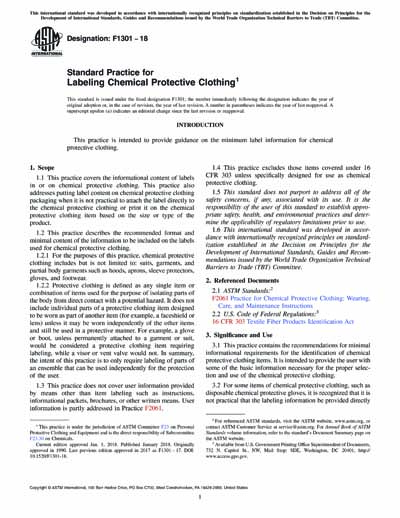Historical
ASTM F1301-18
Standard Practice for Labeling Chemical Protective Clothing
1.1 This practice covers the informational content of labels in or on chemical protective clothing. This practice also addresses putting label content on chemical protective clothing packaging when it is not practical to attach the label directly to the chemical protective clothing or print it on the chemical protective clothing item based on the size or type of the product.
1.2 This practice describes the recommended format and minimal content of the information to be included on the labels used for chemical protective clothing.
1.2.1 For the purposes of this practice, chemical protective clothing includes but is not limited to: suits, garments, and partial body garments such as hoods, aprons, sleeve protectors, gloves, and footwear.
1.2.2 Protective clothing is defined as any single item or combination of items used for the purpose of isolating parts of the body from direct contact with a potential hazard. It does not include individual parts of a protective clothing item designed to be worn as part of another item (for example, a faceshield or lens) unless it may be worn independently of the other items and still be used in a protective manner. For example, a glove or boot, unless permanently attached to a garment or suit, would be considered a protective clothing item requiring labeling, while a visor or vent valve would not. In summary, the intent of this practice is to only require labeling of parts of an ensemble that can be used independently for the protection of the user.
1.3 This practice does not cover user information provided by means other than item labeling such as instructions, informational packets, brochures, or other written means. User information is partly addressed in Practice F2061.
1.4 This practice excludes those items covered under 16 CFR 303 unless specifically designed for use as chemical protective clothing.
1.5 This standard does not purport to address all of the safety concerns, if any, associated with its use. It is the responsibility of the user of this standard to establish appropriate safety, health, and environmental practices and determine the applicability of regulatory limitations prior to use.
1.6 This international standard was developed in accordance with internationally recognized principles on standardization established in the Decision on Principles for the Development of International Standards, Guides and Recommendations issued by the World Trade Organization Technical Barriers to Trade (TBT) Committee.
Content Provider
ASTM International [astm]






